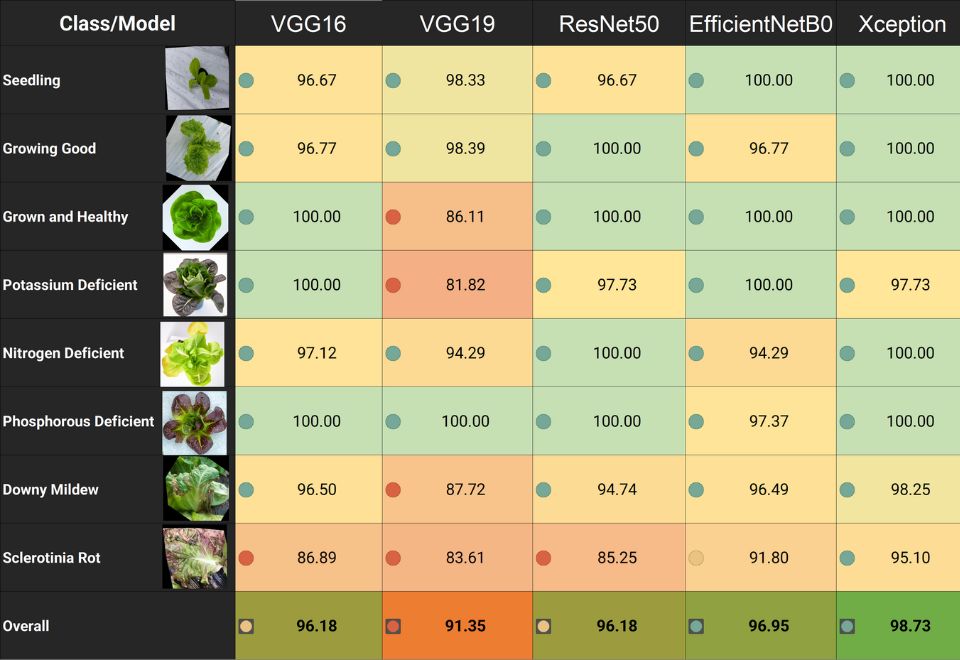Enhancing Crop Monitoring and Sustainability
One such engineering challenge is the real-time tracking of diseases and nutrient deficiencies in lettuce plants using artificial intelligence (AI) technology. When these goals are met, vertical farming can benefit greatly through optimized nutrient delivery, reduced crop loss, and enhanced overall crop health.
In this case study, we used data gathered from vertical farming companies to develop multiple computer vision models to detect and classify nutrient deficiencies and diseases in lettuce plants. By utilizing AI technology, vertical farmers can improve their monitoring abilities, make prompt interventions, and guarantee the best conditions for crop growth, resulting in increased, better-quality yields.
We can change how crops are managed and develop a more sustainable and effective method of agriculture by implementing AI in vertical farming. By enabling precise and data-driven decision-making processes that benefit both farmers and consumers, this application of AI technology to vertical farming has the potential to revolutionize the sector.
Data Collection: The data collection for this challenge was extensively performed by surfing the internet. The nutrient deficiency data was obtained from Kaggle with four classes of lettuce (Fully Nutritional, Nitrogen Deficient, Phosphorus Deficient, and Potassium Deficient), and the disease data was obtained from Roboflow Universe with five classes of lettuce (downy mildew, growing, health, raising seeding, and sclerotinia_rot).
Data Preparation & Augmentation: Data augmentation was performed on each class of images by rotating the images and dividing each image into four pieces in order to improve the training process and make the most of the limited data available. The two datasets, which together contained eight classes for the models to be trained on, were combined to create the final dataset.
Model Selection: VGG16, VGG19, ResNet50, EfficientNetB0, and Xception, convolutional neural network (CNN) models specialized in image classification, were chosen and trained on the final data after extensive research and analysis of the deployment conditions of the AI models. These models were chosen in order to satisfy the deployment requirements for cloud systems, edge devices, and applications.
Hardware: For data preparation, as well as model training, inference, and testing, we utilized a NVIDIA GPU. Not only did the models train much quicker with the GPU than with our local systems, but we were also able to adjust our computing costs to meet our needs thanks to the hardware’s elastic scaling capability.
Experiments: In order to fine-tune the pre-trained models and achieve high accuracy, a number of experiments were conducted, including varying the number of trainable layers, using various batch sizes and optimizers, and setting various dropout and dense layers.
The VGG16 model was able to achieve an overall accuracy of roughly 96%, the VGG19 model was able to achieve an overall accuracy of roughly 91%, the ResNet50 model was able to achieve an overall accuracy of roughly 96%, the EfficientNetB0 model was able to achieve an overall accuracy of roughly 97%, and the Xception model was able to achieve an overall accuracy of roughly 99%.
The accuracy of each model with respect to each class, as well as the overall model accuracies, are shown below.

These results demonstrate the effectiveness of these state-of-the-art AI models in addressing the challenge of identifying nutrient deficiencies and diseases in lettuce plants for vertical farming. The high accuracy rates achieved by these models are indicative of their ability to contribute significantly to the development of autonomous monitoring and management systems in vertical farming, improve crop health, reduce losses, and optimize yields.
We achieved exceptional accuracy in detecting and recognizing nutrient deficiencies and diseases in lettuce plants through considerable experimentation and model fine-tuning. The outcomes were displayed above.
These precise and effective AI models show how they could completely alter the way that vertical farming is done. Farmers may automate crop monitoring and management procedures by incorporating AI technology into vertical farming systems, which could increase yields, lower crop loss, and improve crop health. This would not only benefit the farmers but would also ensure an effective and sustainable method of farming.
The effective application of AI to vertical farming creates opportunities for additional improvements in crop management and prepares the way for self-sufficient and data-driven agricultural methods. AI-powered systems have the potential to greatly improve vertical farming in the future, making it more precise, productive, and environmentally friendly with continued research and development.
